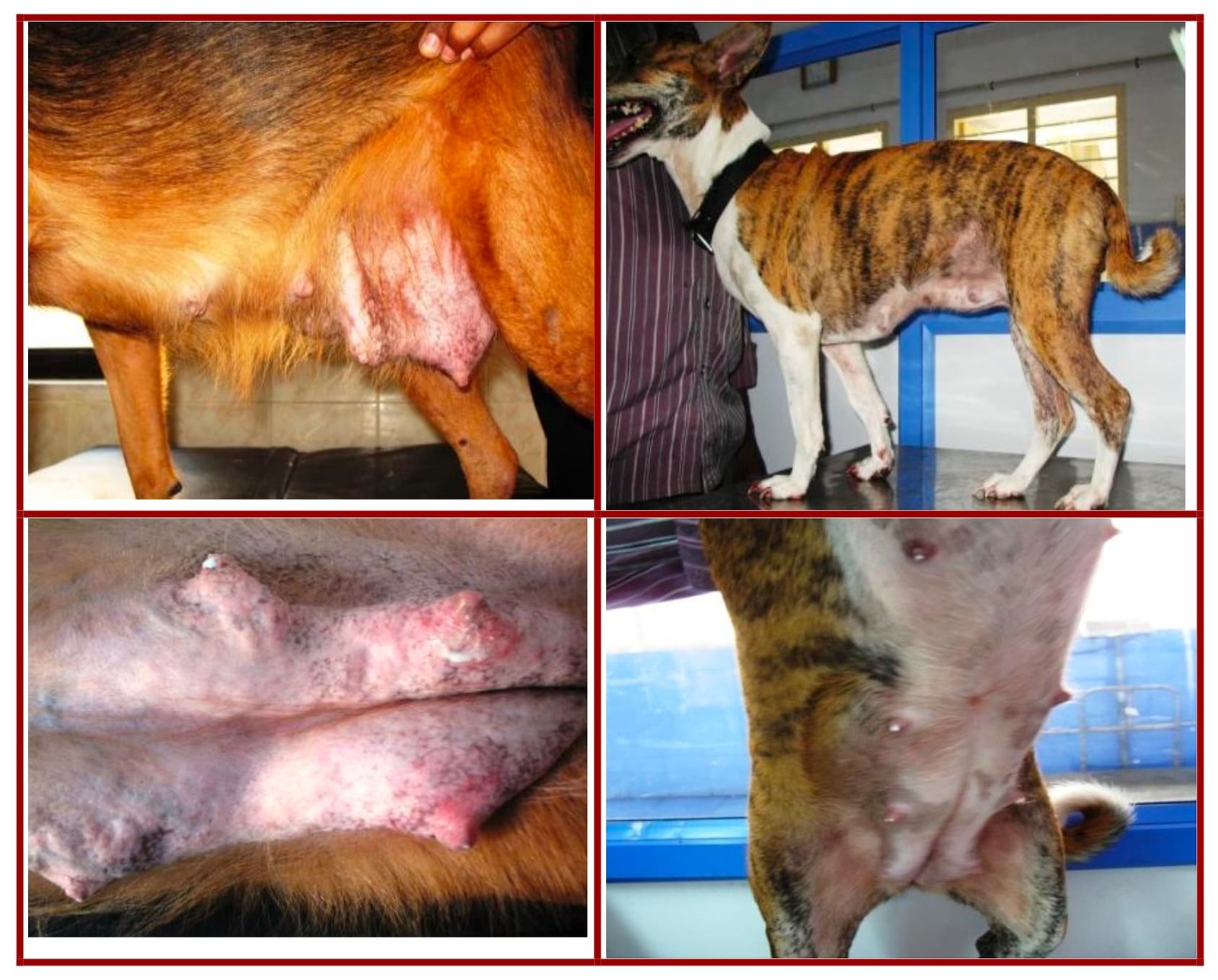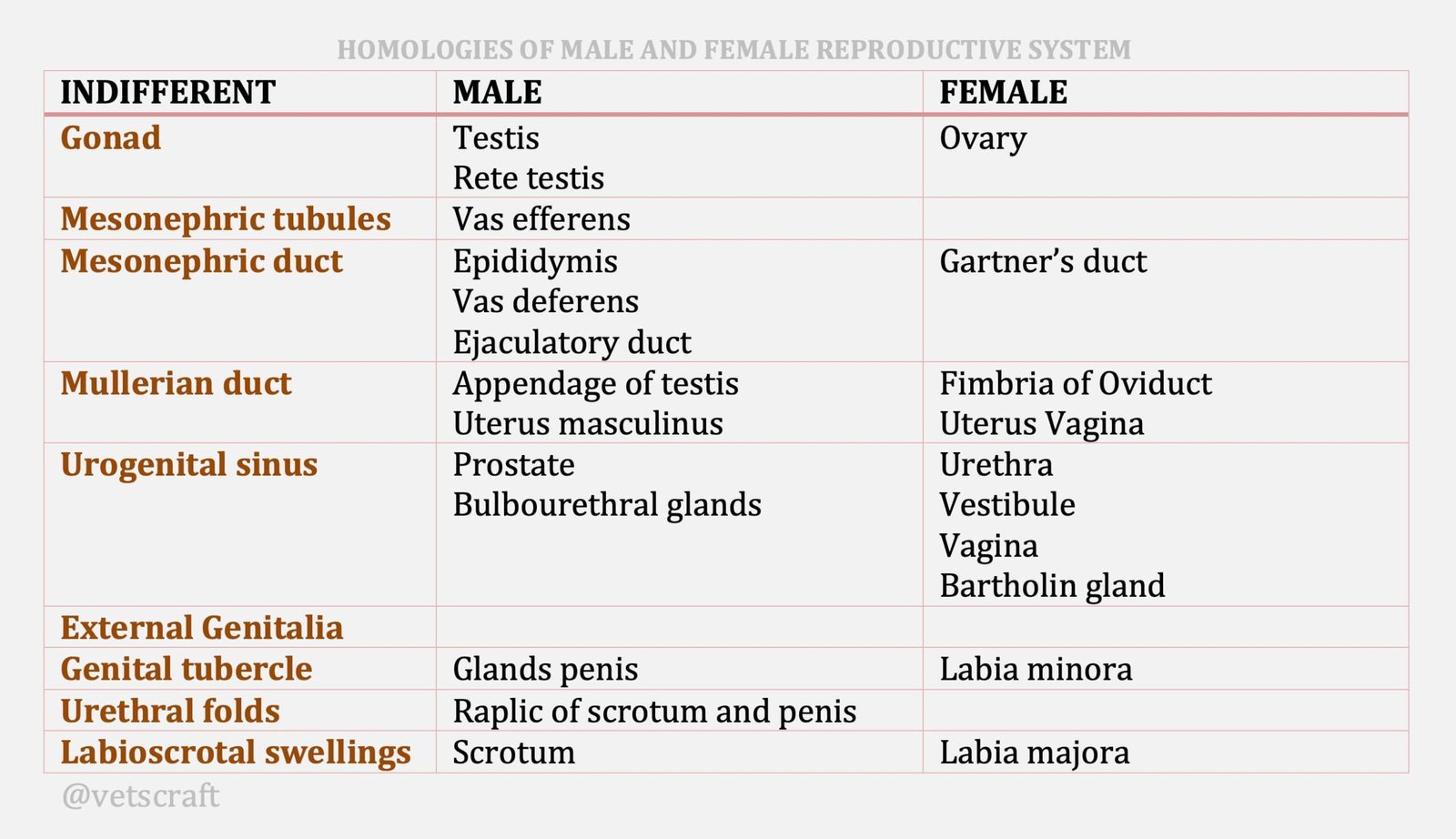TABLE OF CONTENTS
Pseudopregnancy (Pseudocyesis) in Dogs
Pseudopregnancy or pseudocyesis is also called false pregnancy. It is a physiological condition observed in non-pregnant female dogs (bitches), typically occurring 6 to 12 weeks after estrus (heat).
A physical and behavioral condition simulating pregnancy that occurs in the nonpregnant bitch.
In dogs, the clinical condition of overt pseudopregnancy called simply pseudopregnancy, pseudocyesis, false pregnancy or nervous lactation is a syndrome observed in non-pregnant bitches about 6 to 12 weeks after estrus and is characterized by clinical signs such as nesting, weight gain, mammary enlargement and lactation.
Causes and Pathophysiology
During diestrus, nonpregnant bitches with normal ovarian function have serum progesterone concentrations indistinguishable from pregnant bitches. Hence, all non pregnant dogs in diestrus stage of cycle are referred to as pseudopregnant.
Decreasing serum progesterone concentrations and subsequent increases in prolactin secretion at the end of diestrus cause overt manifestations of periparturient behavior to occur only in some dogs and this is referred to as clinical pseudopregnancy. Increased concentration of prolactin or increased sensitivity to prolactin may be the reason why pseudopregnancy occurs in some but not in all bitches.
Signs may be observed in bitches after ovariohysterectomy in diestrus because removal of the ovaries simulates parturition with a rapid drop in progesterone and a consequent rise in prolactin.
Clinical Signs
Mid diestrus signs may be similar to signs of mid gestation:
- Mammary gland development.
- Behavioral changes such as aggression and lethargy.
- Possible weight gain in bitches from overfeeding because owners believed the bitch was pregnant.
- Toward the end of diestrus (60-80 days post estrus), overt periparturient signs appear.
- Nesting, restlessness, aggression, anorexia.
- “Mothering” of inanimate objects.
- Mammary glands may produce normal milk or a brownish watery fluid.
- Mastitis in engorged mammary glands is a possible sequel.
Less common signs of pseudopregnancy are:
- Emesis
- Abdominal enlargement
- Diarrhea
- Polyuria
- Polydipsia
- Polyphagia

Differential Diagnosis
- Normal pregnancy must be ruled out.
- The administration of progesterogens may cause signs of pseudocyesis and milk production may occur when the drug is discontinued.
Treatment
- Therapy is generally necessary only is those bitches showing marked behavioral changes.
- Elizabethan collars to prevent licking of the mammary gland is recommended.
- Licking, milking or use of compresses are potential stimuli for lactation and need to be avoided.
- Signs of pseudocyesis can be abbreviated with mibolerene 16 µg/kg/day PO fir 3-5 days.
- Antiprolactin drugs such as Bromocriptine (10–30 µgms/Kg/day PO for 10-14 days) or Cabergoline (5 µgms/Kg/day PO for 5-10 days) may be administered.
- Side effects such as vomition, anorexia and depression will be observed with Bromocriptine administration. Vomiting can be avoided by administration of anticholinergic drugs such as atropinc.
Aggressive Therapy
Pharmacological approaches to the treatment of moderate to severe pseudopregnancy have historically included steroids, including estrogens, progestins and androgens. More recently the preferred method of treatment is the use of prolactin-suppressing drugs, especially dopamine agonists, whereever available.
Sex Steroid Therapy
Steroids such as estrogens, progestins and androgens have been traditionally used to treat pseudopregnancy but the side effects usually outweigh any benefits of these medications. High doses appear to exert a negative effect, either by suppressing pituitary prolactin or decreasing sensitivity to prolactin.
Estrogens
Estrogens such as diethylstilbestrol, estradiol benzoate or estradiol cipionate have been used. They may cause signs of proestrus or estrus, uterine disease such as pyometra, and anemia due to bone marrow depression. The use of estrogen is not recommended.
Androgens
Androgens including testosterone and synthetic androgens can suppress lactation. Clitoral hypertrophy, virilization, and epiphora are side effects noticed. The synthetic androgen mibolerone has been shown to reduce the duration of pseudopregnancy.
Progestins
Progestins such as megestrol acetate and medroxyprogesterone acetate, administered orally, have been used to suppress the symptoms of overt pseudopregnancy probably by suppressing prolactin secretion or reducing the tissue sensitivity to prolactin. However, withdrawal of progestin results in
recurrence of symptoms including lactation. Progestin administration can cause cystic endometrial hyperplasia-pyometra complex and insulin resistance, as well as mammary gland nodules, mammary tumors, and acromegaly. Administration of progestins is therefore not recommended.
Prolactin-Suppression Therapy
Dopamine Agonists
Secretion of prolactin by the pituitary is mainly under tonic inhibitory control of the hypothalamus, mediated by a direct action of dopamine, the major prolactin inhibiting factor (PIF).
The dopamine agonists bromocriptine and cabergoline are the most common ergot compounds used clinically to inhibit prolactin secretion.
Bromocriptine
Oral administration of Bromocriptine at varying doses ranging from 10 to 100 µg/kg/day for 10 to 14 days has been recommended by various authors. Since, it has a short half-life of + 4 to 6 h and should be administered at least twice a day for greatest efficacy.
Unlike cabergoline, bromocriptine also crosses the blood-brain barrier and can stimulate other brain centers in addition to the hypothalamus. Emetic effects result from stimulation of the hypothalamic vomiting center.
The ED50 for emesis is near the commonly used therapeutic doses and digestive side effects are frequent and proportional to the dose. Common side effects include vomiting, anorexia, depression, and other behavioral changes. Side effects tend to decrease during the course of treatment.
To prevent or reduce the incidence of emesis, bromocriptine can be administered in low and then increasing doses, or administered with the food. In addition, vomiting can be managed by administration of anticholinergic drugs such as atropine.
Bromocriptine is formulated in 2.5 mg tablets for use in humans, and fractionation of the tablets is necessary to achieve dosages of 10 to 30 µg/kg typically administered to pseudopregnant bitches. This makes it difficult to administer exact doses, and may have caused an overestimation of the drug’s side effects.
Preparation of exact dosages is important. Administration of the 10 to 30 µg/kg dose twice or even 3 times a day is preferable to once a day administration.
Cabergoline
Cabergoline has greater bioactivity, superior D2-receptor specificity, and a longer duration of action compared to bromocriptine.
It can be effectively administered once a day. Cabergoline crosses the blood brain barrier only slightly and consequently has much less central emetic effects than some other dopamine agonists.
The ED50 for emesis is 4 times the therapeutic dose and gastrointestinal signs are rare. Cabergoline is used for treating pseudopregnant bitches at a dose of 5 µg/kg/day for 5 to 10 days, given orally.
Anti-Serotonergic
Metergoline
Metergoline, an anti-serotonergic veterinary drug marketed for the treatment of pseudopregnancy in bitches in Europe and in some Latin American countries. It is an ergot alkaloid which has a dopaminergic effect and thus reduces prolactin secretion when administered at high doses.
It has a short half-life and hence has to be administered twice a day. The recommended dose is 0.1 mg/kg, orally, twice a day, for 8 to 10 days.
Anxiety, aggressiveness, hyper excitation and whining are the most frequent side effects of metergoline, which are due to its central anti-serotonergic effect.

